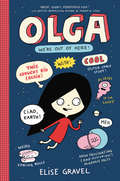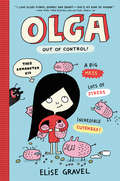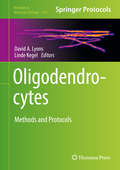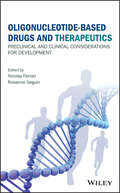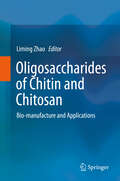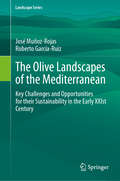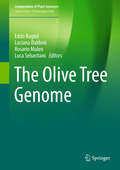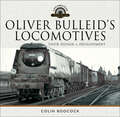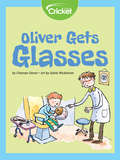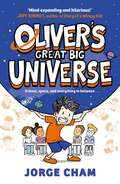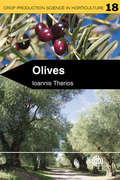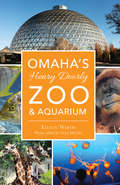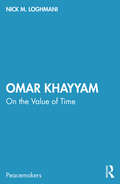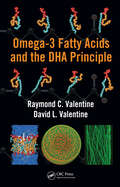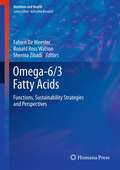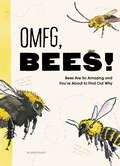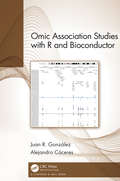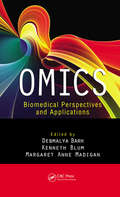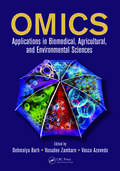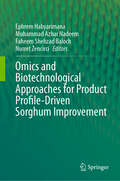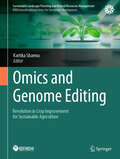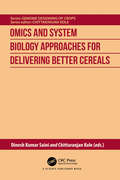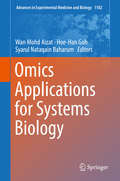- Table View
- List View
Olga: We're Out of Here! (Olga #2)
by Elise GravelAnimal lover and kid scientist Olga is back! Great for fans of the acclaimed graphic novels Real Friends and Invisible Emmie.In this second installment of a series Franny K. Stein creator Jim Benton called “great, kooky, monstrous fun,” Olga wants to leave earth in search of Meh’s home planet, but first she’ll have to discover why Meh is acting so strange.Olga: We’re Out of Here is jam-packed with facts and fun: Elise Gravel’s classic comic illustrations, hilarious word bubbles, space travel facts, and a diverse cast of memorable characters.Brightly.com put Olga and the Smelly Thing from Nowhere on their "Ultimate Summer Reading List for 9- to 12-Year-Olds."And Kirkus said of it: “A visually interesting mix of illustration and story, punctuated by numerous lists, comic panels, and cartoon diagrams and led by a smart female protagonist. A bubble-gum crowd pleaser with wide audience appeal.”
Olga: Out of Control! (Olga #3)
by Elise GravelJoin Olga, the science-loving girl in the red dress, in her most wacky adventure yet! Perfect for fans of Dear Dumb Diary and My Big Fat Zombie Goldfish.In this third installment of the series, Olga’s beloved companion, Meh, is now a mom! She has a litter of adorable babies that look like spring rolls. But the babies aren’t just adorable—they’re a handful! How can Olga stop them from covering her house in rainbow poop if she’s busy making sure they’re fed?Can Olga keep it all under control? Packing in three times the girl power, hilarious quips, and kooky science facts of the previous books, Olga: Out of Control is sure to have kids laughing!
Oligodendrocytes: Methods and Protocols (Methods in Molecular Biology #1936)
by David A. Lyons Linde KegelThis volume looks at the study of oligodendrocytes through in vitro and in vivo techniques, multiple model organisms, using approaches that bridge scales from molecular through system. Chapters in this book cover topics such as fundamental molecular analyses of oligodendrocytes and myelin; in vitro, ex vivo, and in vivo molecular-cellular-electrophysiology-based techniques; oligodendrocyte formation, homeostasis, and disruption in zebrafish and Xenopus; and parallel system-level imaging of animal and human models. Written in the highly successful Methods in Molecular Biology series format, chapters include introductions to their respective topics, lists of the necessary materials and reagents, step-by-step, readily reproducible laboratory protocols, and tips on troubleshooting and avoiding known pitfalls.Authoritative and thorough, Oligodendrocytes: Methods and Protocols is a valuable reference guide that highlights the expansive and fast-paced nature of research into oligodendrocyte biology underlying health and function.
Oligonucleotide-Based Drugs and Therapeutics: Preclinical and Clinical Considerations for Development
by Nicolay Ferrari Rosanne SeguinA comprehensive review of contemporary antisense oligonucleotides drugs and therapeutic principles, methods, applications, and research Oligonucleotide-based drugs, in particular antisense oligonucleotides, are part of a growing number of pharmaceutical and biotech programs progressing to treat a wide range of indications including cancer, cardiovascular, neurodegenerative, neuromuscular, and respiratory diseases, as well as other severe and rare diseases. Reviewing fundamentals and offering guidelines for drug discovery and development, this book is a practical guide covering all key aspects of this increasingly popular area of pharmacology and biotech and pharma research, from the basic science behind antisense oligonucleotides chemistry, toxicology, manufacturing, to safety assessments, the design of therapeutic protocols, to clinical experience. Antisense oligonucleotides are single strands of DNA or RNA that are complementary to a chosen sequence. While the idea of antisense oligonucleotides to target single genes dates back to the 1970's, most advances have taken place in recent years. The increasing number of antisense oligonucleotide programs in clinical development is a testament to the progress and understanding of pharmacologic, pharmacokinetic, and toxicologic properties as well as improvement in the delivery of oligonucleotides. This valuable book reviews the fundamentals of oligonucleotides, with a focus on antisense oligonucleotide drugs, and reports on the latest research underway worldwide. • Helps readers understand antisense molecules and their targets, biochemistry, and toxicity mechanisms, roles in disease, and applications for safety and therapeutics • Examines the principles, practices, and tools for scientists in both pre-clinical and clinical settings and how to apply them to antisense oligonucleotides • Provides guidelines for scientists in drug design and discovery to help improve efficiency, assessment, and the success of drug candidates • Includes interdisciplinary perspectives, from academia, industry, regulatory and from the fields of pharmacology, toxicology, biology, and medicinal chemistry Oligonucleotide-Based Drugs and Therapeutics belongs on the reference shelves of chemists, pharmaceutical scientists, chemical biologists, toxicologists and other scientists working in the pharmaceutical and biotechnology industries. It will also be a valuable resource for regulatory specialists and safety assessment professionals and an important reference for academic researchers and post-graduates interested in therapeutics, antisense therapy, and oligonucleotides.
Oligosaccharides of Chitin and Chitosan: Bio-manufacture and Applications
by Liming ZhaoThe book provides an overview of bio-manufacturing techniques for the production, purification, characterization and modification of chito/chitin oligosaccharides and their monomers. In addition, it explores potential applications in the food, biomedical and agricultural industry on the basis of their bioactivities and biomaterial properties. Lastly, it shares a range of cutting-edge insights to help solve problems in industrial processes and promote further academic investigation. Given its scope, it offers a valuable resource for researchers and graduate students in the fields of bioengineering, food science, biochemistry, etc.
The Olive: Botany and Production
by Giovanni Agosteo Barbera Giuseppe Angjelina Belaj Antonio Belcari Karim Barkaoui Giora Ben-Ari Alon Ben-Gal Giovanni Benelli Rita Biasi Iris Biton Konstantinos Blazakis Aureliano Bombarely Antonio Brunori Santa Olga Cacciola Angelo Canale Giovanni Caruso Dr Tiziano Caruso Nicola Cinosi Arnon Dag Ran Erel Daniela Farinelli Louise Ferguson Tommaso Ganino Jesus A Gil-Ribes Calero José Gómez Riccardo Gucci Consolación Guerrero Panagiotis Kalaitzis Maurizio Lambardi Lauri Pierre-Eric Lorenzo León Bianco Riccardo Lo Enrico Maria Lodolini Francisco Luque Hanene Mairech Picchi Malayka Giulia Marino Roberto Mariotti Francesco Paolo Marra G Medina-Alonso José Mercado Maurizio Micheli Soraya Mousavi Monji Msallem Dvora Namdar Isabel Narváez Elena Palomo-Ríos Ruggero Petacchi Pierluigi Pierantozzi Malayka Samantha Picchi Amalia Rosa Piscopo Fernando Pliego-Alfaro Primo Proietti Alessandro Ragazzi Pilar Rallo Hava F Rapoport Luca Regni Laia Ribalta A. Rosati Patrizia Sacchetti Luca Sebastiani Alicia Serrano Giuseppe Surico Luca Testi Maria Cristina Valeri Andrea Vitale Uri Yermiyahu Hande Yilmaz-Düzyaman Valeria Zeni Isaac Zipori James Friel Raul De Rosa Salvatore Camposeo Garcia Sergio CastroThe European or Mediterranean cultivated olive (Olea europaea L., subsp. europaea, var. europaea) is an ancient crop notable for its early domestication. Today, hundreds of olive varieties are grown to produce high-quality fruit for oil and table olives for human consumption. Over the last 30 years, the olive industry has undergone profound innovation due to scientific and technical advances, particularly in genomics, breeding, orchard management, mechanization and agro-ecology. Not all these developments are currently available to smaller producers. Outside the Mediterranean Basin, where it has been present for over 6,000 years, olive cultivation has spread to many other countries. These new olive-growing areas are helping further the expansion of the industry, due to increased awareness of the nutritional and health properties of extra virgin olive oil. This book is a much-needed update on olive biology and cultivation, with contributions from leading international experts, and includes: Genetics and breeding Olive propagation and nursery Planting olive orchards Horticultural management of olive orchards Plant protection Olive by-products Multifunctionality of olive groves and ecosystem services The Olive: Botany and Production is an invaluable resource for researchers and students in horticulture and agriculture, in addition to producers involved in olive orchard management.
The Olive Landscapes of the Mediterranean: Key Challenges and Opportunities for their Sustainability in the Early XXIst Century (Landscape Series #36)
by José Muñoz-Rojas Roberto García-RuizThis book provides a state-of-the-art review of the current models and typologies of olive landscapes and related farming systems in the Mediterranean. It also explores potential prospects for monitoring and enhancing their sustainability standards. Olive groves are an essential component of the historical landscape that largely drive the cultural, ecological and socio-economic character of the region. Agronomic intensification and mechanization, market globalization and delocalization, and financialization are affecting these ancient farming systems in certain olive landscapes, whereas others are threatened by abandonment and financial loss. This complex set of processes is resulting in a heterogeneous mosaic of olive landscapes when examined across nested spatial-temporal scales and institutional levels. In alignment with such complexity, multiple challenges are arising linked to sustainability standards and targets. Sustainability has actually been the subject of much public discussion and yet of not nearly enough scientific evidence-gathering that is both robust and comparable across geographic contexts and scales. This is where this book is expected to provide a meaningful contribution. Ultimately, the main objective of this book is to establish a base-line sustainability picture of the complex mosaic of olive landscapes across the Mediterranean region. The book is structured along a series of national /regional and thematic reviews and syntheses, which lead to joined-up reflections on current and future challenges, opportunities and trajectories for enhancing the sustainability of olive landscapes across the Mediterranean. The book will be of interest to academics and researchers, policy-makers, the farming community, and market agents alike. We expect that they will find in this book an overall picture of the sector´s current situation and plausible pathways for achieving enhanced sustainability standards, whilst also permitting the reader to gain depth on the contingent characteristics of the different drivers, components and typologies of these dynamic and valuable landscapes.
The Olive Tree Genome
by Eddo Rugini Luciana Baldoni Rosario Muleo Luca SebastianiThis book provides an introduction to the genetics, genomics, and breeding of the olive tree, a multi-functional long-lived crop plant that is relevant not only for culinary olive and oil production, but also for shaping the landscape and history of many rural areas for centuries. Today, the recognized health benefits of extra-virgin olive oil provide new impulses for introducing innovation in olive crop management and olive breeding for a deeper understanding of the biological processes underlying fruit quality, adaptation to crop environment and response to threatening epidemics due to biological agents such as Xylella fastidiosa. The individual chapters discuss genetic resources; classic and modern breeding methods for providing new olive cultivars; the genotype x environment interactions determining the response to biotic and abiotic stresses; fruit metabolism related to oil production and the synthesis of health beneficial molecules; the mapping of genes and quantitative trait locus; and genomic, transcriptomic and proteomic strategies pertinent to the development of a molecular platform and template amenable to precise and rapid genetic modifications using recently developed genome editing tools.
Oliver Bulleid's Locomotives: Their Design & Development (Locomotive Portfolio)
by Colin BoocockA history of the man who served as Chief Mechanical Engineer for the Southern Railway and the many locomotives he developed.Oliver Bulleid’s locomotives guides the reader in the quest to understand what motivated Mr Bulleid in his work as a senior engineer and manager, and tries, with as little bias as is reasonable, to make sense of some of the more controversial aspects of his activities. For example, why did OVB not pursue the ideal of a 2-8-2 for the Southern Railway? How did the ‘Leader’ project go so much out of control? What role did Bulleid play in the massive dieselization program in Ireland when he was CME there? How did the 0-6-6-0T turf-burning steam locomotive fit in with Ireland’s traction policy, or did it? And why did ninety of his steam locomotives and ninety-four of ‘his’ diesels have to be rebuilt to make them either more economical or more reliable?These are fundamental questions to which the book provides the reader with answers based on the author’s experiences or on those of people who knew Bulleid. OVB’s undoubted successes are illustrated in words and photographs, too, to provide a hopefully balanced picture of one of Britain’s more exciting railway engineers.“This book is a well written overview of the Bulleid era, by a competent engineer who can express himself in layman’s terms.” —Martin Shill, Industrial Railway Society“The book deserves a place on the bookshelf of every student of locomotives, especially Bulleid's By current standards, it is good value, and it was a pleasure to examine it.” —The Railway Observer
Oliver Gets Glasses
by Charnan SimonWhen Oliver cannot see the difference between cows and horses, his mom takes him to the eye doctor for the first time! Oliver learns about the eye and how it allows him to see. Dr. Walker then shows him how he is able to tell if the eye is healthy! Will Oliver need to get glasses?
Oliver's Great Big Universe: the laugh-out-loud new illustrated series about school, space and everything in between!
by Jorge Cham&‘Mind-expanding and hilarious!&’ Jeff Kinney, author of the bestselling DIARY OF A WIMPY KID series. This hilarious new illustrated series will make you laugh-out-loud AND grow your brain. Perfect for readers age 8+ and fans of Diary of a Wimpy Kid and The 13-Storey Treehouse. Hi, I&’m Oliver! I know what you&’re thinking: what does an 11-year-old kid know about the universe? Am I a famous scientist? No. Am I a super-genius? Not really. I&’m just trying to figure out the usual stuff: new school, new friends, how to avoid my annoying sister. But there&’s one thing that DOES make sense: science! Outer space is totally my thing and I can tell you EVERYTHING you need to know about awesome stuff like: time-bending black holes how the Big Bang is like a fart aliens! (Well, there could be aliens.) From bestselling writer and robotics engineer Jorge Cham, Oliver&’s Great Big Universe is the first book in a STEM-themed, diary-style series. &‘An absolute gem!&’ Lincoln Peirce, author of the bestselling series BIG NATE. &‘A stellar confluence of comic episodes and cosmic information. In addition to brilliantly integrated comic moments – surprising plot twists add narrative pizzazz to a serious raft of data about the universe. An irresistibly entertaining introduction to astrophysics.&’ – Kirkus starred review &★
Olives
by Ioannis TheriosOlive culture is growing rapidly, and expanding all over the world outside traditional centres of olive growth and production. Olives are not only a significant food source, but also contribute to human health and are becoming popular in health-conscious diets far beyond their Mediterranean origins.Reviewing an extensive array of literature from both a theoretical and practical perspective, this comprehensive guide deals with all aspects of olive culture, from its history, origins and traditional techniques to the latest horticultural procedures and basic physiology. The book's accessible and broadly illustrated format makes it an indispensable text for students, interested individuals and both active and amateur horticulturists.
Ollie and Harry's Marvelous Adventures
by Ollie Ferguson Harry FergusonOutdoor adventure and makerspace tech combine in this inspiring how-to from the brothers behind the popular Facebook page "The Days Are Just Packed." Ollie and Harry Ferguson have sailed a toy pirate ship across the Atlantic, engineered a giant catapult, and launched toy astronauts into space—and they haven’t stopped there. They’ve created a list of 500 adventures to help them live life to its fullest, from setting up a wildlife reserve to building an igloo. Ollie and Harry’s Marvelous Adventures features the best of the boys’ escapades, captured in vivid photographs and accompanied by step-by-step guidance on how to replicate them. The brothers’ days are just packed—and with the help of this inspiring guide, yours can be too.
Omaha’s Henry Doorly Zoo & Aquarium (Landmarks)
by Carol Mccabe Eileen WirthLong ranked as one of the top zoos in America and even the world, Omaha’s Henry Doorly Zoo & Aquarium’s history has remained untold, until now. Beginning as little more than a menagerie, the zoo transformed into a spectacular attraction that now draws two million visitors per year. Supporters responded to innovative features such as the iconic desert dome, the new African Grasslands exhibit, the indoor jungle and the all-encompassing aquarium. More than just a showcase, the zoo also supports renowned wildlife conservation and research programs that help preserve endangered species ranging from coral reefs to tigers. Author Eileen Wirth celebrates the history and promising future of the landmark that continues to elicit great local pride.
Omar Khayyam: On the Value of Time (Peacemakers)
by Nick M. LoghmaniThis book explores the life and work of Omar Khayyam as a provocateur of peace. While Khayyam is known for his poetry, he was foremost a prominent mathematician who looked at the world from a unique perspective. Using the transformative power of mathematics, he brought together seemingly irreconcilable concepts in his work. Through his art, philosophy, and mathematics, Khayyam sought to create harmony between what on the surface looks like a clash between his scientific view, romantic and often provocative poetry, and philosophy. The book sheds light on his spiritual and philosophical journey through a cross-sectional account of his poetry, philosophical view, and mathematics and science. It explores the complex inner life of a multidimensional scholar as he negotiated between faith and science, constructing a framework for peace by looking at the world as it presents itself to us, contemplating the temporality of life and enriching it with wisdom and joy. Historically and culturally informed, this book will be indispensable to readers of Omar Khayyam’s poetry and philosophy. It will also be of interest to students and researchers of peace and conflict studies, mathematics, science, Middle East literature, history, and popular culture.
Omega-3 Fatty Acids and the DHA Principle
by Raymond C. Valentine David L. ValentineThe physical-chemical properties of the omega-3 fatty acid DHA (docosahexaenoic acid) enable it to facilitate rapid biochemical processes in the membrane. This effect has numerous benefits, including those involved in the growth of bacteria, rapid energy generation, human vision, brain impulse, and photosynthesis, to name a few. Yet DHA also carrie
Omega-6/3 Fatty Acids
by Fabien De Meester Ronald Ross Watson Sherma ZibadiOver the last several years developing human research suggests that a component of omega-3 fatty acids, long chain ones, contribute particularly to health benefits. Omega-6/3 Fatty Acids: Functions, Sustainability Strategies and Perspectives focuses on developing information on this newly recognized key component. This volume uniquely, and for the first time, focuses on sustainability of natural sources of omega-3 fatty acids variants including long chain ones, and on ways to increase their use and availability to reduce major diseases. The authors review cardiovascular disease, neurological changes and mental health and other diseases like diabetes where long chain omega-3 fatty acids play protective roles from recent human trials. Each chapter evaluates developing information on the possible mechanistic role of long chain omega-3 fatty acids. After showing their requirement and involvement in health promotion there are reviews of various sources and ways to protect and promote them. Authors provide support for the benefits and sources of long chain omega-3 fatty acids and their increased dietary intake that reduce various physical and mental illnesses. Omega-6/3 Fatty Acids: Functions, Sustainability and Perspectives is a unique and important new volume that provides the latest data and reviews to physicians who need to assess serum omega-6/3 and fatty acids to help diagnose risks and change diets and to inform industry and the scientific community with reviews of research for actions including new studies and therapies.
OMFG, BEES!: Bees Are So Amazing and You're About to Find Out Why
by null Matt KrachtAre you ready for the ultimate bee book? With lighthearted watercolor and ink drawings, humorous quips, lists, and musings, OMFG, BEES! will show you just how important these esteemed bee-list celebrities really are. (Hint: We can't live without them.)Delving into various bee topics, from distinguishing between bees and not bees (very crucial), to exploring the absolute wonder that is bee behavior (they do a coded dance directing their bee friends to food, for crying out loud!), to divulging the mind-blowing bee-magic behind honey making (within some extremely intricate and precisely constructed hexagonal honeycomb, no big deal), and more, Kracht's ode to bees paints a charming and enthusiastic picture of our favorite pollinators.Bee-autiful full-color illustrations fill these pages that playfully and earnestly examine different kinds of bees, from the honeybee to the teddy bear bee, providing unbelievably cool facts about bees and reasons why they deserve a lot more credit as well as our appreciation and advocacy. Because omfg, BEES!!
Omic Association Studies with R and Bioconductor
by Juan R. González Alejandro CáceresAfter the great expansion of genome-wide association studies, their scientific methodology and, notably, their data analysis has matured in recent years, and they are a keystone in large epidemiological studies. Newcomers to the field are confronted with a wealth of data, resources and methods. This book presents current methods to perform informative analyses using real and illustrative data with established bioinformatics tools and guides the reader through the use of publicly available data. Includes clear, readable programming codes for readers to reproduce and adapt to their own data. Emphasises extracting biologically meaningful associations between traits of interest and genomic, transcriptomic and epigenomic data Uses up-to-date methods to exploit omic data Presents methods through specific examples and computing sessions Supplemented by a website, including code, datasets, and solutions
OMICS: Biomedical Perspectives and Applications
by Debmalya Barh Kenneth Blum Margaret Anne MadiganA reflection of the explosion of research and development in this field, OMICS: Biomedical Perspectives and Applications explores applications of omics in bioinformatics, cancer research and therapy, diabetes research, plant science, molecular biology, and neurosciences. A select editorial panel of experts discusses their cutting edge omics researc
OMICS: Applications in Biomedical, Agricultural, and Environmental Sciences
by Debmalya Barh Vasudeo Zambare Vasco AzevedoWith the advent of new technologies and acquired knowledge, the number of fields in omics and their applications in diverse areas are rapidly increasing in the postgenomics era. Such emerging fields-including pharmacogenomics, toxicogenomics, regulomics, spliceomics, metagenomics, and environomics-present budding solutions to combat global challeng
Omics and Biotechnological Approaches for Product Profile-Driven Sorghum Improvement
by Ephrem Habyarimana Muhammad Azhar Nadeem Faheem Shehzad Baloch Nusret ZencirciThis edited book is focused on Sustainable Development Goal 2, which aims to achieve 'Zero Hunger.' It provides deep insights into the global sorghum status, limitations to its production, advancements in agronomic practices, and the application of high-throughput phenotyping technologies. Sorghum plays a vital role in global food security, agricultural sustainability, and rural livelihoods, making it an important crop for both developing and developed countries. It is a staple food for millions of people around the world, particularly in arid and semi-arid regions where other crops may struggle to grow. Sorghum exhibits significant genetic diversity, providing a rich resource for breeding programs aimed at developing improved varieties with traits such as higher yield, disease resistance, and nutritional quality. The book enhances readers' understanding of classical breeding methods and their role in sorghum improvement. It also focuses on the contribution of OMICs and biotechnological approaches to sorghum improvement. Detailed information about the genetic and genomic resources of sorghum provided is helpful for the scientific community to utilize in sorghum breeding. Chapters highlight sorghum genome sequencing, transgenic and hybrid sorghum, and the application of genome editing. This book is useful to the breeding community, serving as a resource for interdisciplinary research groups such as geneticists, breeders, biotechnologists, bioinformaticians, and students, supporting them in accelerating their activities related to sorghum breeding.
Omics and Genome Editing: Revolution in Crop Improvement for Sustainable Agriculture (Sustainable Landscape Planning and Natural Resources Management)
by Kartika SharmaThis book offers up-to-date research on genome editing and omics technologies from renowned academics with established backgrounds from throughout the globe. The world population is expected to touch 9–10 billion by 2050 and to feed the growing population, 50% more food must be produced globally than is currently produced. Nonetheless, it is a difficult challenge to increase the food output of the currently existing crops on available land. Over the past few decades, traditional crop enhancement techniques like plant breeding and other agricultural technology have made a significant contribution to food and nutritional security. With the use of strong technologies, genome editing strategies can significantly improve the productivity and efficiency of current agricultural practices. Discovering the underlying mechanisms influencing features of economic value has been made possible through genome editing through CRISPR/Cas9, primer and base editing, and OMICs through genomics, proteomics, metabolomics, transcriptomics, and phenomics. This book provides a wealth of information on omics and genome editing approaches and their application to develop abiotic, biotic, and climate-tolerant crops, as well as RNA interference, next-generation sequencing, and metabolomics for sustainable crop production. Researchers are actively using both genome editing and omics for crop improvement; however, there is limited literature offered in a single source. Undergraduate and postgraduate students, researchers, policymakers, and stakeholders will find this book to be an invaluable resource.
Omics and System Biology Approaches for Delivering Better Cereals (Genome Designing of Crops)
by Dinesh Kumar Saini Chittaranjan KoleThe book explores the available omics resources, the integration of multi-omics data, and systems biology methods, focusing on their applications in cereals breeding and research. It highlights current and innovative strategies to understand complex traits, to improve yield, and to enhance resistance to biotic and abiotic stresses. It also addresses the challenges and opportunities associated with modeling multi-omics data and analyzing systems-level information. By leveraging systems biology and integrated omics research, this book aims to redefine the future research agenda for cereal improvement.
Omics Applications for Systems Biology (Advances in Experimental Medicine and Biology #1102)
by Wan Mohd Aizat Hoe-Han Goh Syarul Nataqain BaharumThis book explains omics at the most basic level, including how this new concept can be properly utilized in molecular and systems biology research. Most reviews and books on this topic have mainly focused on the technicalities and complexity of each omics’ platform, impeding readers to wholly understand its fundamentals and applications. This book tackles such gap and will be most beneficial to novice in this area, university students and even researchers. Basic workflow and practical guidance in each omics are also described, such that scientists can properly design their experimentation effectively. Furthermore, how each omics platform has been conducted in our institute (INBIOSIS) is also detailed, a comprehensive example on this topic to further enhance readers’ understanding. The contributors of each chapter have utilized the platforms in various manner within their own research and beyond. The contributors have also been interactively integrated and combined these different omics approaches in their research, being able to systematically write each chapter with the conscious knowledge of other inter-relating topics of omics. The potential readers and audience of this book can come from undergraduate and postgraduate students who wish to extend their comprehension in the topics of molecular biology and big data analysis using omics platforms. Furthermore, researchers and scientists whom may have expertise in basic molecular biology can extend their experimentation using the omics technologies and workflow outlined in this book, benefiting their research in the long run.
